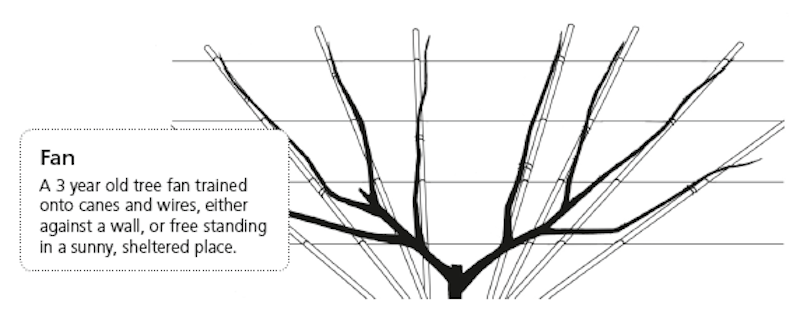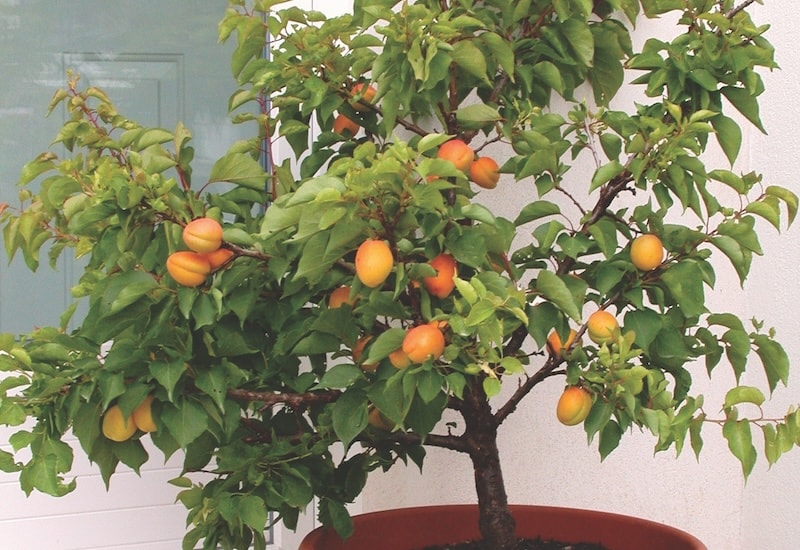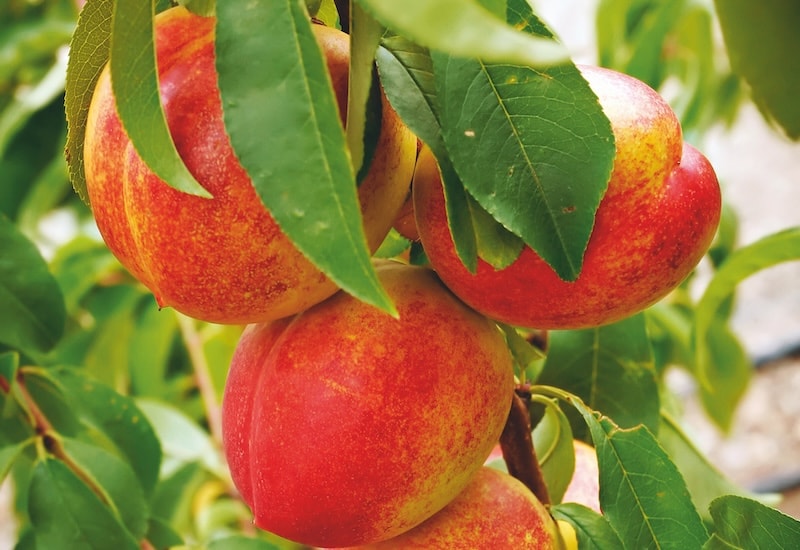Growing apricots, peaches and nectarine trees is perfectly possible here in the UK. With the advent of new rootstocks and modern varieties, these lovely fruits are now hardy enough for garden cultivation. For best results, fan train them against a bright south or southwest-facing wall so they benefit from the warmth of the sun throughout the day and then, during the night, from the residual heat from the bricks. Alternatively, in the absence of a suitable wall, choose a sheltered, sunny spot where your sweet stone fruits can ripen.
Browse our full range of apricot, peach and nectarine trees to find the perfect variety for your garden.
How to fan train apricot, peach and nectarine trees

Image: Suttons
Before planting, erect a trellis against your chosen wall. The lattice should be 1ft square, and the trellis panel should measure approx 2.1m (7′) long by 1.8m (6′) high. Attach a fan of 2.4m (10 x 8′) canes to this, which will support and guide the tree’s branches. Plant the tree against the trellis at the base of the fan.
Shortly after the tree produces its first leaves, cut back the central leader – the main stem – to about 45cm (18″) above ground level. As the side branches develop, tie them to the canes to encourage them to grow in the direction you want them to go. Use soft string rather than wire so you don’t damage the tender young stems. If you live in one of the milder parts of the UK, you may also wish to try growing your peaches and nectarines as free-standing bush plants.
After the first year, prune back the branches of your fruit trees by up to one-half to encourage feathering – the development of side branches. By this time, enough branches should be present to have enough for each cane, and the final fan shape will start to develop. In time, fruit buds will develop on the small sub-branches along each main branch of the fan.
How to get the best harvests from peaches, nectarines, and apricots

Image: Apricot ‘Flavorcot’® from Suttons
Peaches, nectarines and apricots flower early in the spring, often as early as late-February. While the blossom is quite resistant to frost damage, protect the flowers from heavy frosts by draping the tree with a protective cover of horticultural fleece overnight.
At this time of year, very few pollinating insects are active, so it’s well worth giving your trees a little help by hand pollinating to ensure a good set of fruit. Using a very soft artist’s brush or even a make-up brush, gently introduce the tip into the flowers, transferring pollen from one to the next. A sunny day is the best time to tackle this task.
How to prune and care for peach, nectarine, and apricot trees

Image: Nectarine ‘Madame Blanchette’ from Suttons
Prune your peach and nectarine trees during early spring at the early leaf stage. This reduces the risk of spreading bacterial canker and silver leaf infection.
Peach leaf curl is likely to be a problem with peaches and nectarines, although, happily, apricots don’t tend to suffer. The responsible fungus is carried in raindrops, infecting the dormant bud cases in winter.
There are two ways of protecting your trees. First, prevent raindrops from hitting your trees with a polythene sheet, which you attach to the wall above your tree and lower into position during rainy spells – this method has the added advantage of protecting blossoms against frost. The second way to protect your trees from leaf curl is to apply Bordeaux mixture or other copper-based fungicide at leaf fall and again in early February.
Mulch your stone fruit trees with compost containing plenty of organic matter in the late spring and autumn, applying plenty of material to feed your trees, conserve moisture in the soil, and deter weeds. Just keep the stems clear of mulch to prevent rot.
Growing delicious, juicy nectarines, peaches, and apricots is perfectly possible, especially in the warmer southern areas of the UK. New, hardy rootstocks and a good pruning, training and mulching regime will keep your trees in tip-top condition. Like to get the most fruit from a small space? Read our guide to pruning and training apple trees for more tips.
Lead image: Peach ‘Peregrine’ from Suttons
Last Updated on September 5, 2024 by Suttons Horticultural Team





